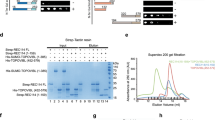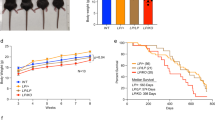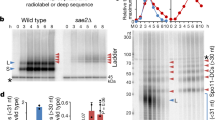Abstract
In Saccharomyces cerevisiae, meiotic recombination is initiated by Spo11-dependent double-strand breaks (DSBs), a process that precedes homologous synapsis. Here we use an antibody specific for a phosphorylated histone (γ-H2AX, which marks the sites of DSBs) to investigate the timing, distribution and Spo11-dependence of meiotic DSBs in the mouse. We show that, as in yeast, recombination in the mouse is initiated by Spo11-dependent DSBs that form during leptotene. Loss of γ-H2AX staining (which in irradiated somatic cells is temporally linked with DSB repair) is temporally and spatially correlated with synapsis, even when this synapsis is 'non-homologous'.
This is a preview of subscription content, access via your institution
Access options
Subscribe to this journal
Receive 12 print issues and online access
$209.00 per year
only $17.42 per issue
Buy this article
- Purchase on Springer Link
- Instant access to full article PDF
Prices may be subject to local taxes which are calculated during checkout





Similar content being viewed by others
References
Roeder, G.S. Meiotic chromosomes: it takes two to tango. Genes Dev. 11, 2600–2621 (1997).
Baker, S.M. et al. Male mice defective in the DNA mismatch repair gene PMS2 exhibit abnormal chromosome synapsis in meiosis. Cell 82, 309–319 (1995).
Pittman, D.L. et al. Meiotic prophase arrest with failure of chromosome synapsis in mice deficient for Dmc1, a germline-specific recA homolog. Mol. Cell 1, 697–705 (1998).
Yoshida, K. et al. The mouse RecA-like gene Dmc1 is required for homologous chromosome synapsis during meiosis. Mol. Cell 1, 707–718 (1998).
Edelmann, W. et al. Mammalian MutS homologue 5 is required for chromosome pairing in meiosis. Nature Genet. 21, 123–127 (1999).
de Vries, S.S. et al. Mouse MutS-like protein MSH5 is required for proper chromosome synapsis in male and female meiosis. Genes Dev. 13, 523–531 (1999).
Kneitz, P. et al. MutS homolog 4 localization to meiotic chromosomes is required for chromosome pairing during meiosis in male and female mice. Genes Dev. 14, 1085–1087 (2000).
Rogakou, E.P., Boon, C., Redon, C. & Bonner, W.M. Megabase chromatin domains involved in DNA double-strand breaks in vivo. J. Cell Biol. 146, 905–915 (1999).
Rogakou, E.P., Pilch, D.R., Orr, A.H., Ivanova, V.S. & Bonner, W.M. DNA double-stranded breaks induce histone H2AX phosphorylation on serine 139. J. Biol. Chem. 273, 5858–5868 (1998).
Page, J., Suja, J.A., Santos, J.L. & Rufas, J.S. Squash procedure for protein immunolocalization in meiotic cells. Chromosome Res. 6, 639–642 (1998).
Calenda, A., Allenet, B., Escalier, D., Bach, J.-F. & Garchon, H.-J. The meiosis-specific Xmr gene product is homologous to the lymphocyte Xlr protein and is a component of the XY body. EMBO J. 13, 100–109 (1994).
Lammers, J.H.M. et al. The gene encoding a major component of synaptonemal complexes of rat is related to X-linked lymphocyte-regulated genes. Mol. Cell. Biol. 14, 1137–1146 (1994).
Meuwissen, R.L.J. et al. A coiled-coil related protein specific for synapsed regions of meiotic prophase chromosomes. EMBO J. 11, 5091–5100 (1992).
Peters, A.H., Plug, A.W., van Vugt, M.J. & de Boer, P. A drying-down technique for the spreading of mammalian meiocytes from the male and female germ line. Chromosome Res. 5, 66–68 (1997).
Dobson, M., Pearlman, R.E., Karaiskakis, A. & Spyropoulos, B. Synaptonemal complex proteins: occurrence, epitope mapping and chromosome disjunction. J. Cell Sci. 107, 2749–2760 (1994).
Plug, A.W., Xu, J., Reddy, G., Golub, E.I. & Ashley, T. Presynaptic association of Rad51 protein with selected sites in meiotic chromatin. Proc. Natl Acad. Sci. USA 93, 5920–5924 (1996).
Keeney, S., Giroux, C.N. & Kleckner, N. Meiosis-specific DNA double-strand breaks are catalyzed by Spo11, a member of a widely conserved protein family. Cell 88, 375–384 (1997).
Baudat, F., Manova, K., Yuen, J.P., Jasin, M. & Keeney, S. Chromosome synapsis defects and sexually dimorphic meiotic progression in mice lacking Spo11. Mol. Cell 6, 989–998 (2000).
Romanienko, P.J. & Camerini-Otero, R.D. The mouse Spo11 gene is required for meiotic chromosome synapsis. Mol. Cell 6, 975–987 (2000).
Peters, A.H., Plug, A.W. & de Boer, P. Meiosis in carriers of heteromorphic bivalents: sex diferences and implications for male fertility. Chromosome Res. 5, 313–324 (1997).
Moses, M.J. & Poorman, P.A. Synaptonemal complex analysis of mouse chromosomal rearrangements. II. Synaptic adjustment in a tandem duplication. Chromosoma 81, 519–535 (1981).
Barlow, A.L., Benson, F.E., West, S.C. & Hultén, M.A. Distribution of the RAD51 recombinase in human and mouse spermatocytes. EMBO J. 16, 5207–5215 (1997).
Moens, P.B. et al. Rad51 immunocytology in rat and mouse spermatocytes and oocytes. Chromosoma 106, 207–215 (1997).
Tarsounas, M., Morita, T., Pearlman, R.E. & Moens, P.B. RAD51 and DMC1 form mixed complexes associated with mouse meiotic chromosome cores and synaptonemal complexes. J. Cell Biol. 147, 207–219 (1999).
McKim, K.S. et al. Meiotic synapsis in the absence of recombination. Science 279, 876–878 (1998).
Dernburg, A.F. et al. Meiotic recombination in C. elegans initiates by a conserved mechanism and is dispensable for homologous chromosome synapsis. Cell 94, 387–398 (1998).
Ashley, T. An integration of old and new perspectives of mammalian meiotic sterility. in Results and Problems in Cell Differentiation (ed. McElreavey, K.) 131–173 (Springer, Berlin, 2000).
Eijpe, M., Offenberg, H., Goedecke, W. & Heyting, C. Localisation of RAD50 and MRE11 in spermatocyte nuclei of mouse and rat. Chromosoma 109, 123–132 (2000).
Raderschall, E., Golub, E.I. & Haaf, T. Nuclear foci of mammalian recombination proteins are located at single-stranded DNA regions formed after DNA damage. Proc. Natl. Acad. Sci. USA 96, 1921–1926 (1999).
Gasior, S.L., Wong, A.K., Kora, Y., Shinohara, A. & Bishop, D.K. Rad52 associates with RPA and functions with rad55 and rad57 to assemble recombination complexes. Genes Dev. 12, 2208–2221 (1998).
Mahadevaiah, S.K., Setterfield, L.A. & Mittwoch, U. Univalent sex chromosomes in spermatocytes of Sxr-carrying mice. Chromosoma 97, 145–153 (1988).
Plug, A.W. et al. Changes in protein composition of meiotic nodules during mammalian meiosis. J. Cell Sci. 111, 413–423 (1998).
McKee, B.D. & Handel, M.A. Sex chromosomes, recombination, and chromatin conformation. Chromosoma 102, 71–80 (1993).
Alsheimer, M. & Benavente, R. Changes of karyoskeleton during mammalian spermatogenesis: expression pattern of nuclear lamin C2 and its regulation. Exp. Cell Res. 228, 181–188 (1996).
Earnshaw, W.C. & Rothfield, N. Identification of a family of human centromere proteins using autoimmune sera from patients with scleroderma. Chromosoma 91, 313–321 (1985).
Escalier, D. & Garchon, H.-J. XMR is associated with the asynapsed segments of sex chromosomes in the XY body of mouse primary spermatocytes. Chromosoma 109, 259–265 (2000).
Acknowledgements
We thank H.-J. Garchon for the anti-XLR antibody; P. Moens and B. Spyropoulos for the anti-COR1 and anti-SYN1 antibodies; A. Davies, J.-Y. Masson and S. West for the anti-DMC1 antibody; R. Benavente for the anti-SCP3 antibody; W. Earnshaw for the CREST antibody; H. te Riele for providing Msh5−/− mice; S. Pagakis for help with imaging; and Á. Rattigan and O. Ojarikre for help with mouse genotyping and breeding.
Author information
Authors and Affiliations
Corresponding author
Rights and permissions
About this article
Cite this article
Mahadevaiah, S., Turner, J., Baudat, F. et al. Recombinational DNA double-strand breaks in mice precede synapsis. Nat Genet 27, 271–276 (2001). https://doi.org/10.1038/85830
Received:
Accepted:
Issue Date:
DOI: https://doi.org/10.1038/85830
This article is cited by
-
SRSF1 regulates primordial follicle formation and number determination during meiotic prophase I
BMC Biology (2023)
-
FIGNL1 AAA+ ATPase remodels RAD51 and DMC1 filaments in pre-meiotic DNA replication and meiotic recombination
Nature Communications (2023)
-
Improving effects of telmisartan on spermatogenic disorder induced by fractionated low-dose irradiation in mice
International Urology and Nephrology (2023)
-
The RNA-binding protein FUS/TLS interacts with SPO11 and PRDM9 and localize at meiotic recombination hotspots
Cellular and Molecular Life Sciences (2023)
-
The meiotic topoisomerase VI B subunit (MTOPVIB) is essential for meiotic DNA double-strand break formation in barley (Hordeum vulgare L.)
Plant Reproduction (2023)



